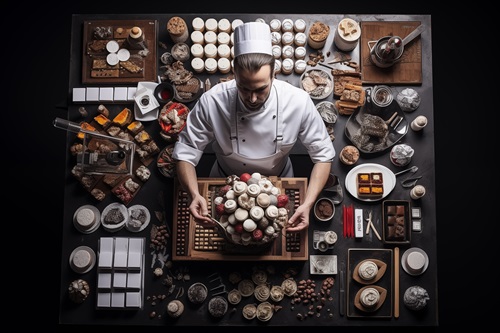In a sunlit, fragrant bakery kitchen, a pastry chef stands surrounded by an artfully arranged collection of ingredients and tools, a scene that brings to mind the meticulous art of knolling. This chef, a maestro of dough and sugar, is more than just a baker; he is an alchemist transforming basic elements into edible masterpieces. The tableau around him, organized with geometric precision, is not just for aesthetic value; it's a reflection of the precision and passion that drives his culinary creations.
The Pastry Chef: An Artist and Scientist in the Culinary World
The pastry chef, dressed in a crisp white coat and a flour-dusted apron, represents a unique blend of artist and scientist. His role is multifaceted: he is a creator of delicate pastries, a designer of intricate desserts, and a technician adept in the chemistry of baking. The art of pastry making demands not only creativity and flair but also an exacting adherence to technique and detail.
The Principle of Knolling: Organizational Art in the Pastry Kitchen
The chef's workspace is a canvas where the principle of knolling—a method of arranging related items in parallel or 90-degree angles—is beautifully manifested. This layout enhances both efficiency and precision in the baking process. Each ingredient and tool is placed deliberately, allowing for seamless transitions between different stages of pastry preparation.
Ingredients: The Palette of the Pastry Chef
Encircling the chef is a variety of high-quality ingredients, essential to the art of pastry making. Bags of fine flour, granulated and powdered sugars, jars of artisanal honey, and blocks of butter form the foundation. Nearby, fresh fruits, including berries, citrus, and apples, await their transformation into fillings and garnishes.
Eggs, a staple in the pastry kitchen, are strategically placed. Various nuts, chocolate chunks, and an array of spices like cinnamon, nutmeg, and vanilla pods add complexity and depth to his creations. Containers of cream, milk, and artisanal cheeses like mascarpone and ricotta speak to the rich textures and flavors he expertly infuses into his pastries.
The Chef's Role: Beyond Baking
The pastry chef's role goes beyond simply mixing and baking. It involves an intimate understanding of how different ingredients interact under varying conditions. He knows precisely how temperature, humidity, and proportions impact the texture and flavor of his creations.
His expertise extends to skillfully manipulating dough, crafting airy pastries, and creating luscious creams and custards. The chef is also a master decorator, adept at using icing, fondant, and chocolate to turn desserts into visual feasts.
In Conclusion: A Symphony of Sweets and Creativity
As the pastry chef works, there's a rhythm to his movements, an elegant dance of creation. The knolled layout of his ingredients and tools is a testament to his commitment to organization and precision. Each pastry, pie, or cake that emerges from his oven is not just a treat for the taste buds but a celebration of the art of pastry making.
In this space, the pastry chef continues to enchant and delight, one exquisite dessert at a time, upholding the traditions of his craft while infusing it with his unique creative vision.

